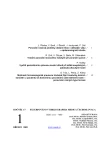-
Medical journals
- Career
Physeal injury of distal tibia in children – epidemiological study
Authors: Ladislav Plánka; Vladimír Bartl; Jan Škvařil; Jiří Jochymek; Petr Gál
Authors‘ workplace: Clinic of paediatric surgery, orthopaedics and traumatology, University hospital Brno ; Klinika dětské chirurgie, ortopedie a traumatologie Fakultní nemocnice Brno
Published in: Úraz chir. 17., 2009, č.1
Overview
AIM:
Distal tibial fractures represent 25–35 % of all fractures in children; they are the second most frequented fractures after the distal radial fractures. Approximately 4 % of them damaged the distal tibial growth plate. The aim of this study was to analyse all patients with distal tibial epiphyseal fractures and results of their treatment in Clinic of paediatric surgery, orthopaedics and traumatology in last 11 years.METHODS:
207 children aged 0–19 were completely treated in Clinic of paediatric surgery, orthopaedics and traumatology with distal tibial epiphyseal fractures from 1. 1. 1997 to 31. 12.2007. The X-ray images from injury to completely consolidation were controlled, the treatment, clinical results and occurrence of complications too. The successful result of healing was without angulation (less than 5 °), shortening (less than 1 cm) and the other complications.RESULTS:
In sum, 141 (68,3 %) patients were treated conservatively and 66 (31,8 %) patients were treated under general anaesthesia. In whole patient group no clinical disorders were recorded (pain or mobility of the ankle after injury). In eight cases the angulation of distal tibia more than 5 ° after therapy was noted. The second most common complication was redisplacement after closed reduction (7 patients), solely by SH II (17 % of all displaced SH II). In five cases the repeated reduction and in two cases the osteosynthesis were the final resolution.CONLUSION:
This watched diagnostic – therapeutical process results in 93% excellent clinical outcomes. Complication incidence rate of this process is a little lower compared to foreign studies. So, this diagnostic – therapeutic process can be used as diagnostic – therapeutic standard for this type of physeal injury in children.KEY WORDS:
tibia, growth plate, childhood, epiphyseolysis.
Sources
1. AItken, A.P. The End Results of the Fractured Distal Tibial Epiphysis. J Bone Joint Surg. 1936, 18, 685–691.
2. Beaty, J.H., Kasser, J.R. Rockwood and Wilkin's fractures in children. Philadelphia: Lippincott Williams & Wilkins, 2001. 334 s.
3. CHADWICK, C.J. Spontaneous resolution of varus deformity at the ankle following adduction injury of the distal tibial epiphysis. J Bone Joint Surg. 1982, 64A, 774.
4. Chen, F., Hui, J.H.P., Chan, W.K., Lee, E.H. Cultured mesenchymal stem cell transfers in the treat-ment of partial growth arrest. J Pediatr Orthop. 2003, 23, 425–429.
5. Crenshaw, a.h., Carothers, c.o. Clinical Significance of a Classification of Epiphyseal Injuries at the Ankle. Am J Surg. 1955, 89, 879–889.
6. Cutler, L., Molloy, A., Dhukuram, V., BassDo, A. Does CT scans aid assessment of distal tibial physeal fractures? J Bone Joint Surg. 2004, 86-B, 239–243.
7. Lalonde, K.A., Letts, M. Traumatic growth arrest of the distal tibia: a clinical and radiographic review. Canadian Journal of Surgery. 2005, 48, 143–147.
8. Mayr, J.M., Pierer, G.R., Linhart, W.E. Re-construction of part of the distal tibial growth plate with an autologous graft from the iliac crest. J Bone Joint Surg. 2000, 82-B, 558–560.
9. Morrissy, R.T., Wcinstein, S.L. Lovell and Winter's pediatric orthopedics. Philadelphia: Lippin-cott Williams & Wilkins, 2001. 1632 s.
10. Peterson, C.A., Peterson, H.A. Analysis of the incidence of injuries to the epiphyseal growth plate. J Trauma. 1972, 12, 275–281.
11. PlÁnka, L., Nečas, A., Gál, P., Kecová, H., Filová, E., Křen, L., Krupa, P. Prevention of bone bridge formation using transplantation of the autogenous mesenchymal stem cells to physeal defects: An experimental study in rabbits. Acta Vet Brno. 2007, 76, 253–263.
12. Planka, L., Gal, P., Kecova, H., Klima, J., Hlucilova, J., Filova, E., Amler, E., Krupa, P., Kren, L., Srnec, R., Urbanova, L., Lorenzova, J., Necas, A. Allogeneic and autogenous transplantations of MSCs in treatment of the physeal bone bridge in rabbits. BMC Biotechnol. 2008, 8, 70.
13. Poland, J., Traumatic Separation of the Epiphysis. London: Smith, Elder & Co, 1898. 230 s.
14. Rockwood, C. A., Wilkins, K. E., King, R. E. Fractures in children, 6th ed. Philadelphia: J.B. Lip-pincott Company, 2006. 1200 s.
15. ŠNAJDAUF, J., CVACHOVEC, K., TRČ, T. Dětská traumatologie. Praha: Galén, 2002. 180 s.
16. VON LAER, L. Pediatric Fractures and Disloca-tions, Stuttgart: Georg Thieme Verlag, 2004. 518 s.
17. VON LAER, L. Der posttraumatische partielle Vers-chluss der distalen Tibiaepiphysenfuge: Ursache, Prognose und Prophylaxe. Teil I. u II. Unfallheil-kunde. 1982, 85, 445–509.
Labels
Surgery Traumatology Trauma surgery
Article was published inTrauma Surgery

2009 Issue 1
Most read in this issue- Physeal injury of distal tibia in children – epidemiological study
- The use of percutaneous transfer of bone marrow in the treatment of aseptic non-unions of long bones
- Pelvic ring injury and traction associated bladder trauma
Login#ADS_BOTTOM_SCRIPTS#Forgotten passwordEnter the email address that you registered with. We will send you instructions on how to set a new password.
- Career

